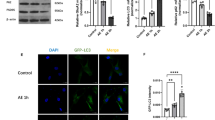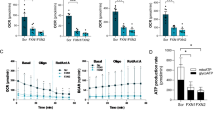Abstract
We have recently shown that sustained neonatal hyperthyroidism in the rat activates apoptosis of oligodendroglial cells (OLGc) and that inhibition of the proteasome-ubiquitin (Ub) pathway by lactacystin produces increased apoptosis in cerebellar granule cells (CGC). In the present study we have analyzed the relationship between the activation of the Ub-dependent pathway, the expression of the Ub genes and programmed cell death in neurons of the rat cerebellum and cerebral cortex and in OLGc. This study was carried out in normal animals, in rats submitted to sustained neonatal hyperthyroidism and in cell cultures treated with an excess of thyroid hormones. In neurons of the cerebral cortex, thyroid hormone produces an increase of Ub-protein conjugates, an enhancement in the expression of the Ub genes and an increase in apoptosis, while the opposite results are obtained in CGC. These results indicate that in neurons, the changes in the cell death program produced by thyroid hormone run in parallel with those occurring in the Ub-dependent pathway. In OLGc, thyroid hormone increases apoptosis but does not produce changes in the Ub pathway. Preliminary studies indicate that in coincidence with what occurs in optic nerves, the sciatic nerves both in controls and in hyperthyroid animals are unable to form Ub-protein conjugates. These results indicate that in cells of the CNS such as neurons, in which the Ub-dependent pathway is actively expressed, it appears to be closely correlated with apoptosis.
Similar content being viewed by others
REFERENCES
Eayrs, J. T. 1964. Effect of neonatal hyperthyroidism on maturation and learning in the rat. Anim. Behav. 12:195-199.
Pasquini, J. M., and Adamo, A. M. 1994. Thyroid hormones and the central nervous system. Dev. Neurosci. 16:1-8.
Bhat, N. R., Bubba Rao, G., and Pieringer, R. A. 1981. Investigation on myelination “in vitro.” Regulation of sulfolipid synthesis by thyroid hormone in cultures of dissociated brain cells from embryonic mice. J. Biol. Chem. 256:1167-1171.
Pasquini, J. M., Faryna de Raveglia, I., Capitman, N., and Soto, E. F. 1981. Neonatal hypothyroidism and early undernutrition in the rat: Defective maturation of structural membrane components in the central nervous system. Neurochem. Res. 6:979-991.
Virgili, M., Saverino, O., Vaccari, M., Barnabei, O., and Contestabile, A. 1991. Temporal, regional and cellular selectivity of neonatal alteration of the thyroid state on neurochemical maturation in the rat. Exp. Brain Res. 83:555-561.
Patel, A. J., Hunt, A., and Kiss, J. 1989. Neonatal thyroid deficiency has differential effects on cell specific markers for astrocytes and oligodendrocytes in the rat brain. Neurochem. Int. 15:239-248.
Walters, S. N., and Morell, P. 1981. Effects of altered thyroid states on myelinogenesis. J. Neurochem. 36:1792-1801.
Adamo, A. M., Aloise, P. A., Soto, E. F., and Pasquini, J. M. 1990. Neonatal hyperthyroidism in the rat produces an increase in the activity of microperoxisomal marker enzymes coincident with biochemical signs of accelerated myelination. J. Neurosci. Res. 25:353-359.
Nicholson, J. L., and Altman, J. 1972. The effects of early hypo-and hyperthyroidism on the development of rat cerebellar cortex I. Cell proliferation and differentiation. Brain Res. 44:13-23.
Wiechsel, M. E. 1974. Effect of thyroxine on DNA synthesis and thymidine kinase activity during cerebellar development. Brain Res. 78:455-465.
Muller, Y., Rocchi, E., Lazaro, J. B., and Clos, J. 1995. Thyroid hormone promotes bcl-2 expression and prevents apoptosis of early differentiating cerebellar granule neurons. Int. J. Dev. Neurosci. 13:871-885.
Baas, D., Bourbeau, D., Sarlieve, L. L., Ittel, M. E., Dussault, J. H., and Puymirat, J. 1997. Oligodendrocyte maturation and progenitor cell proliferation are independently regulated by thyroid hormone. Glia 19:324-332.
Marta, C. B., Adamo, A. M., Soto, E. F., and Pasquini, J. M. 1998. Sustained neonatal hyperthyroidism in the rat affects myelination in the central nervous system. J. Neurosci. Res. 53: 251-259.
Ooka, H., Fujita, S., and Yoshimoto, E. 1983. Pituitary-thyroid activity and longevity in neonatally thyroxine-treated rats. Mech. Aging Dev. 22:113-120.
Timiras, P. 1986. Neuroendocrine System and Aging. Pages 51-57, in Vezzadini P., Facchini A., Labo G. (eds.), Thyroid hormones, brain monoamines and the aging brain, Rijswijk, Eurage.
Delic, J., Morange, M., and Magdelenat, H. 1993. Ubiquitin pathway involvement in human lymphocyte gamma-irradiation induced apoptosis. Mol. Cell. Biol. 13:4875-4883.
Cocks, J. A., Balazs, R., Johnson, A. L., and Eayrs, J. T. 1970. Effects of thyroid hormone on the biochemical maturation of rat brain: Conversion of glucose-carbon into amino acids. J. Neurochem. 17:1275-1285.
Lowry, O. H., Rosebrough, N. J., Farr, A. L., and Randall, R. J. 1951. Protein measurement with the Folin phenol reagent. J. Biol. Chem. 193:265-275.
Adamo, A. M., Besio Moreno, M, Soto, E. F., and Pasquini, J. M. 1994. Ubiquitin-protein conjugates in different structures of the central nervous system of the rat. J. Neurosci. Res. 38:358-364.
Ciechanover, A., Heller, H., Elias, S., Haas, A. L., and Hershko, A. 1980. ATP-dependent conjugation of reticulocyte proteins with the polypeptide required for protein degradation. Proc. Natl. Acad. Sci. USA 77:1365-1368.
Levine, R., Garland, D., Oliver, C., Amici, A., Climent, I., Lenz, A., Ahn, B., Shaltiel, S., and Stadman, E. 1990. Determination of carbonyl content in oxidatively modified proteins. Methods Enzymol. 186:464-478.
Oberhammer, F., Fritsch, G., Schimied, M., Pavelka, M, Prinz, D., Purchio, T., Lassmann, H., and Schulte-Hermann, R. 1993. Condensation of the chromatin at the membrane of an apoptotic nucleus is not associated with activation of an endonuclease. J. Cell Sci. 104:317-326.
Gallo, V., Kingsbury, A., Balazs, R., and Jorgensen, O.S. 1987. The role of depolarization in the survival and differentiation of cerebellar granule cells in culture. J. Neurosci. 7:2203-2213.
Borodinsky, L. N., and Fiszman, M. L., 1998. Extracellular potassium concentration regulates proliferation of immature cerebellar granule cells. Dev. Brain Res. 107:43-48.
Mc Carthy, K. D., and DeVellis, J. 1980. Preparation of separate astroglial and oligodendroglial cell cultures from rat cerebral tissue. J. Cell. Biol. 85:890-902.
Berti-Mattera, L. N., Larocca, J. N., de Iraldi, A. P., Pasquini, J. M., and Soto, E. F. 1984. Isolation of oligodendroglial cells from young and adult whole rat brains using an in situ generated Percoll density gradient. Neurochem. Int. 6:41-50.
Ponzoni, M., Bocca, P., Chiesa, V., Decensi, A., Pistoia, V., Raffaghello, L., Rozzo, C., and Montaldo, P. G. 1995. Differential effects of N-(4-hydroxyphenyl) retinamide and retinoic acid on neuroblastoma cells. Apoptosis versus differentiation. Cancer Res. 55:853-861.
Adamo, A. M., Llesuy, S. F., Pasquini, J. M., and Boveris, A. A. 1989. Brain chemiluminescence and oxidative stress in hyperthyroid rats. Biochem. J. 263:273-277.
Adamo, A. M., Pasquini, L. A., Besio Moreno, M., Oteiza, P. I., Soto, E. F., and Pasquini, J. M. 1999. Effect of oxidant systems on the ubiquitylation of proteins in the central nervous system. J. Neurosci. Res. 55:523-531.
Ciechanover, A. 1994. The Ubiquitin-proteasome proteolytic pathway. Cell 79:13-21.
Hershko, A., and Ciechanover, A. 1998. The Ubiquitin system. Ann. Rev. Biochem. 67:425-479.
Ferrer, I., Pozas, E., and Planas, A. M. 1997. Ubiquitination of apoptotic cells in the developing cerebellum of the rat following ionizing radiation or methylazoxymethanol injection. Acta Neuropathol. 93:402-407.
Soldatenkov, V. A., and Dritschilo, A. 1997. Apoptosis of Ewing' sarcoma cells is accompanied by accumulation of ubiquitinated proteins. Cancer Res. 57:3881-3885.
Tanimoto, Y., Onishi, Y., Hashimoto, S., and Kizaki, H. 1997. Peptidyl aldehyde inhibitors of proteasome induce apoptosis rapidly in mouse lymphoma RVC cells. J. Biochem. 121: 542-549.
Tawa, N. E. Jr, Odessey, R., and Golberg, A. L. 1997. Inhibitors of the proteasome reduce the accelerated proteolysis in atrophying rat skeletal muscles. J. Clin. Inv. 100:197-203.
Adamo, A. M., Besio Moreno, M., Carrasco, A., and Pasquini, J. M. 1997. Expression of the Ubiquitin genes in brain of normal and Fe/dextran injected rats. Neurochem. Res. 22:345-350.
Author information
Authors and Affiliations
Rights and permissions
About this article
Cite this article
Pasquini, L.A., Marta, C.B., Adamo, A.M. et al. Relationship Between the Ubiquitin-Dependent Pathway and Apoptosis in Different Cells of the Central Nervous System: Effect of Thyroid Hormones. Neurochem Res 25, 627–635 (2000). https://doi.org/10.1023/A:1007554902352
Issue Date:
DOI: https://doi.org/10.1023/A:1007554902352




